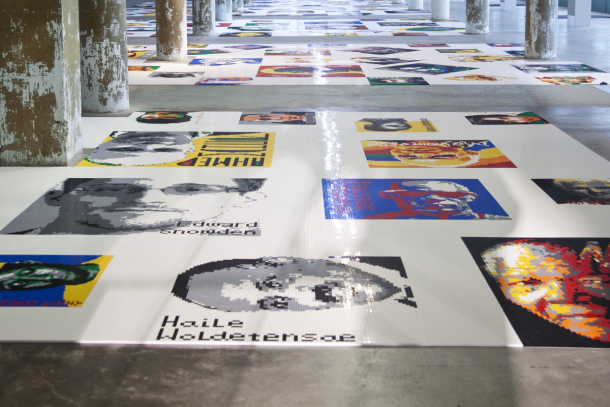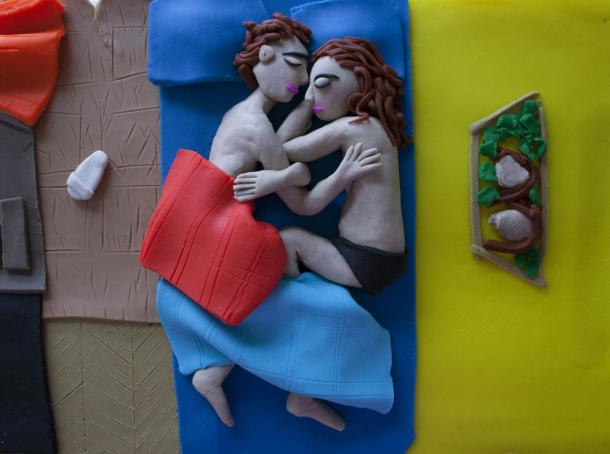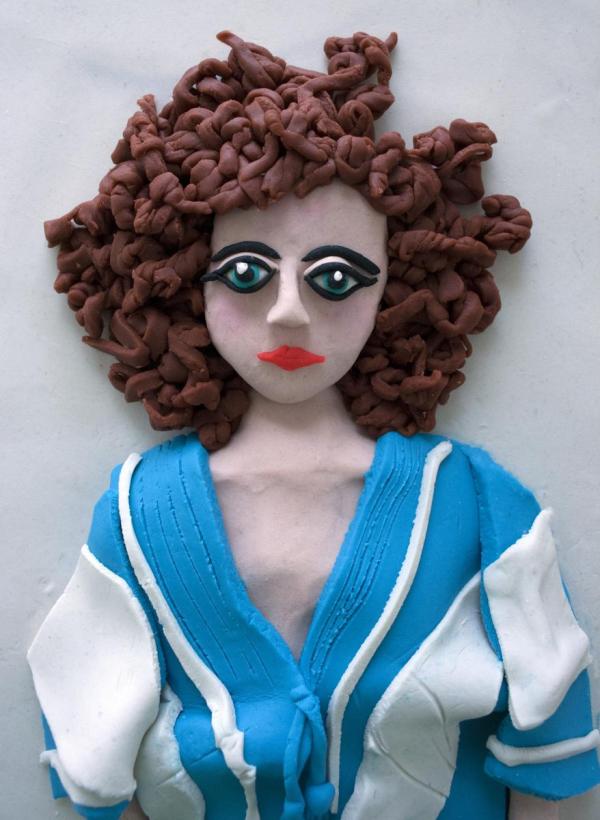
Ten years ago, the Old Truman Brewery was home to the YBAs Art Car Boot Fair, where Gavin Turk and Sarah Lucas partied whilst flogging their artistic wares. Today - and until April 2015 - it hosts the Art of the Brick, an exhibition of LEGO sculptures by former corporate lawyer turned pop icon sculptor Nathan Sawaya.
In a coincidence that struggles to fit into any reasonable theoretical framework, the radical dissident Chinese artist Ai Weiwei’s installation in Alcatraz jail not only closes at the same time as Art of the Brick but features an installation created with LEGO.
Ai Weiwei’s is the more challenging work, as you might imagine. The Beijing-based conceptual artist and activist lurches from playful spectacle - filling the Tate’s Turbine Hall with millions of porcelain seeds - to investigative art - like filming the aftermath of the Sichuan earthquake in 2008 - and has been in various forms of detention on and off since 2011. Commissioned for a site-specific installation exploring human rights and freedom of expression at the decommissioned Alcatraz prison in the San Francisco Bay, he supplied seven new sculptures, including a field of 1.2 million LEGO bricks depicting the faces of 176 dissidents imprisoned or exiled because of their beliefs.

“Ai initially had the idea to use LEGOs for the portraits from observing his five-year-old son, who frequently plays with them,” explains Cheryl Haines, at the FOR-SITE Foundation - which commissioned the work. “He wanted a material that’s able to connect with audiences of diverse ages and backgrounds, and LEGOs are simple and straightforward. They can also be easily destroyed and taken apart, ready to be remade and reimagined — an idea related to the fragility and endurance of freedom. Also, assembling approximately 1.2 million brick into a vast and layered whole, speaks to the relationship between the individual and the collective, a central dynamic in any society and a particularly charged one in China.”

Ai himself is confined to Beijing, so the portraits were fabricated to his specifications by a team of 80 volunteers from San Francisco and several of Ai’s studio assistants. Nathan Sawaya was able to travel with his sculptures but his work, shall we say, struggles to resonate at the frequency of the human soul in quite the same way as Ai’s.
The first two rooms at the Sawaya exhibition are LEGOland-style recreations of famous works - including the Mona Lisa and Michelangelo’s David - followed by giant pencils, apples and the ephemera of his artist’s studio rendered in LEGO brick form.
“These were the first works I completed,” he explains over the phone from LA. “I was working as a corporate lawyer during the day but expressing myself as an artist in the evenings - I was working in sculpture, using anything from clay to candy when I started experimenting with LEGO and just trying to see what I could make.”
The rest of the exhibition is more conceptual - death masks, kissing couples, disintegrating human forms, all accompanied by Upworthyish self-help maxims from the artist: "Swim against the current! Follow your own path! Find the courage within!" or "Sometimes when you’re looking for a step up, you don’t have to look any further than yourself. We’re all capable of more than we think."
“My job is to inspire,” he explains. “I like positivity.”
Sawaya’s debut exhibition in 2007 - at the Lancaster Museum of Art in Pennsylvania - attracted some 20,000 visitors. The museum’s annual average is 35,000. Whatever materials you use, that still spells “kerching”. He’s now one of LEGO’s 12 Certified Professionals - a group that includes Japanese sculptor Jumpei Mitsui, Chicago architect Adam Reed Tucker and Flemish comedian and portrait artist Dirk Denoyelle. To emphasise the death of the old order, YBA sponsor Charles Saatchi has recently purchased work by The Little Artists - John Cake and Darren Neave - who make versions of contemporary artworks like Damien Hirst’s pickled shark from LEGO Harry Potter sets.
What’s going on? LEGO was invented back in 1949 by a devoutly spiritual carpenter turned toymaker Ole Kirk Christiansen - although clearly qualified to create Pinocchio, he went for the plastic bricks instead. It was a canny move - the company made money every year until 1993 when a brief dip in profits created widespread board level panic and a drive to diversify into LEGO-branded electronics, amusement parks, interactive video games and jewelry. “LEGO followed all the advice of the experts and created an innovative disruptive culture that seemingly would have been the envy of any firm,” according to David Robertson, author of Brick by Brick: How LEGO Reinvented Its Innovation System and Conquered the Toy Industry. “And yet it failed and almost collapsed.”
Since 2004, LEGO has given up competing with computer games and focused on the plastic bricks - but it has expanded culturally. Into making movies, of course - “everyone at my screening of The LEGO Movie immediately understood the true nature of God” one US critic enthused - but also into crowd funding, allowing fans - generally adult - to suggest and vote on future projects including the Minecraft set, the Back To The Future DeLorean and the Ghostbusters anniversary set via the LEGO Ideas site.
The company’s unsuccessful exposure to the vicissitudes of head-to-head product tie-ins has forced it back into the more experimental. “Many people suggest amazing ideas for us but they’re not playable and they’re not suitable,” explains Tormod Askildsel, LEGO’s senior director of community engagement. “We screen out things that are too violent, too adult or too destructive. We can’t just pick the hot IP suggestions or that’s all we’ll be - the cult movie adaptation department. We have to pick ideas that are not just what we know will sell.”
So why would artists suddenly respond to this toy? It’s true there’s a deep seated affection for the brick that seems to transcend the kind of cultural boundaries that traditionally block the spread of Hollywood movies, decadent pop or the Albanian vajtim song cycle.
Alex Allmont is an experimental musician who build instruments from LEGO and finds it allows audiences in to some of his more complex work if they see it being performed on a Heath Robinson device made from a familiar childhood toy: “[A]lthough I initially used the bricks to kind of recreate the playful state I was in when I used them as a kid,” he explains. “I think it’s really helpful for artists to find that state and it allows all sorts of ideas to happen.”
However, it’s not just LEGO that artists are embracing. Aphex Twin collaborator Pierre Bastien constructs instruments using Meccano whilst Eleanor MacNair – who used to work at London’s White Cube gallery – renders iconic photographs in Play-Doh. Her book - poetically titled Photographs Rendered In Play-Doh - is published this month.
MacNair started in 2013, using two chopping boards, a highball glass as a rolling pin and £40 worth of Play-Doh, which she recycles - each picture lasts an hour at most before its taken apart and stuffed back in the pot. Since she started posting on Tumblr she’s been followed by big name photographers - who often bid unsuccessfully for their works to be next - and the casually interested from around the world.

“I’m not speaking for the other artists, but I know my pictures have benefitted from the new wave of online curators - essentially sites like Buzzfeed who pick up work they admire and share it,” she explains.

“That brings a new populist aesthetic to the art world. I doubt I’d have my work published if it wasn’t for the twinning of those democratic curators with the photographers I personally know.”
Although Ai Weiwei has yet to give an interview on his work, it’s tempting to see that additional element to his thinking. If you’re launching Agit Prop art in an age where buying £10,000 worth of gold bullion on a beach in the poverty stricken heart of collapsing post-industrial Folkestone merely excites ‘ain’t it cool’ headlines, using the brick guarantees headlines that at least reference the otherwise forgotten political dissidents he’s picked out.
And perhaps that’s one future for art that’s about more than the artist. LEGO’s basement is stocked with copies of every kit the company has made. When adults are shown the kits made in the year they were roughly seven, it invariably produces tears in their eyes. In order to be heard through the noise of indifference, it’s much easier to reach us when we’re seven years old.